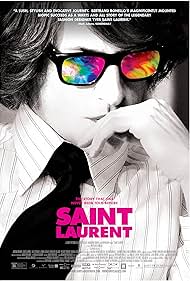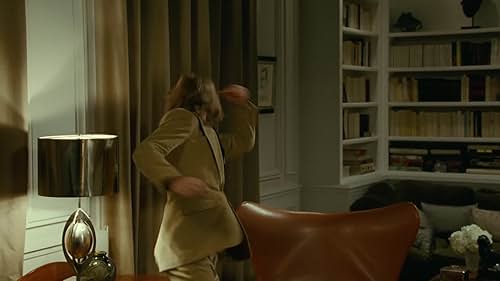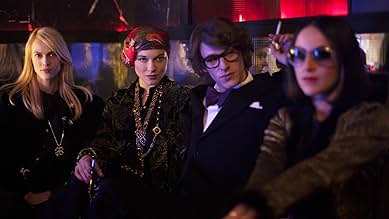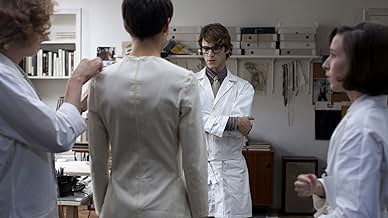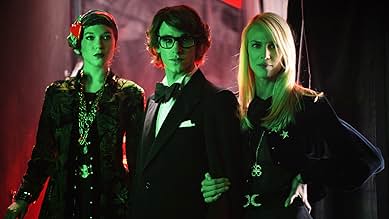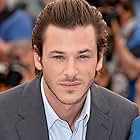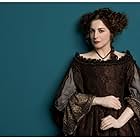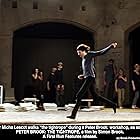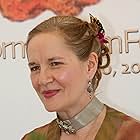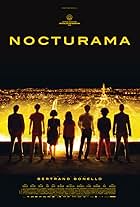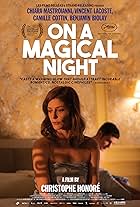IMDb RATING
6.1/10
6.6K
YOUR RATING
Yves Saint Laurent's life from 1967 to 1976, during which time the famed fashion designer was at the peak of his career.Yves Saint Laurent's life from 1967 to 1976, during which time the famed fashion designer was at the peak of his career.Yves Saint Laurent's life from 1967 to 1976, during which time the famed fashion designer was at the peak of his career.
- Awards
- 9 wins & 30 nominations
Valeria Bruni Tedeschi
- Mme Duzer - une cliente
- (as Valeria Bruni-Tedeschi)
Storyline
Did you know
- TriviaThis was one of two films about Yves Saint-Laurent to be released in 2014 and to be nominated for Best Actor award at the 2015 Césars. The other was Yves Saint Laurent (2014), whose star Pierre Niney ended up winning the award.
- GoofsThe translator in the boardroom scene mistranslated the sales numbers: in French she's told the sales increased from 1.3m up to 2.6m, but she translates it to English as 1.6m up to 2.3m.
- Quotes
Loulou de la Falaise: This is style. Fashion passes like a train.
- Crazy creditsThe actors are listed without the names of the characters they're playing.
- ConnectionsFeatured in Evening Urgant: Gaspard Ulliel (2014)
Featured review
It is rather unusual that two French biographic films about the prêt-à-porter fashion icon Yves Saint Laurent (1936-2008) both came out in the same calendar year, YVES SAINT LAURENT opened in January 2014, directed by actor-turns-director Jalil Lespert, stars a rather unknown Pierre Niney as our protagonist and Guillaume Gallienne (the triple threat of 2014 CÉSAR AWARDS winner ME, MYSELF AND MUM 2013, 7/10) as his business partner and life companion Pierre Bergé. While Bertrand Bonello's more ambitious and high-profile SAINT LAURENT debuted in Cannes last year, with Gaspard Ulliel and Jérémie Renier take the central roles as Yves and Pierre.
They are on a collision course in this year's CÉSAR AWARDS, SL leads with 10 nominations including BEST PICTURE and BEST DIRECTOR, and YSL has 7 nominations all in acting and technique branches, eventually SL ends up with a sole win for BEST COSTUME DESIGN and Niney trounces Ulliel for the much coveted BEST LEADING ACTOR honor (good-looking is also a stumbling block in winning recognitions from your peers, and it is a double-standard between male and female). The latter must have a strong heart to accept defeat to an peer actor who plays the same character in another movie, one sure thing is that he doesn't invest less for the role than Niney, and in my book, Ulliel overshadows Niney in emulating Yves' unique utterance and detailed mannerism, this could really hurt one's confidence and ego in this throat-cutting showbiz.
The time-lines are overlapping, YSL is a less flamboyant and a more narrative-centered piece starts from the beginning of Yves' career, whereas SL mainly focuses on a decade from 1967 to 1976, the acme of his career, although it runs a 150-minutes compared with the former's moderate 106 minutes, with whimsical jumps of his childhood and senile stage (played by Helmut Berger).
Basically YSL is presented as a recollection from Mr. Berge's perspective, so the large chunk of Yves' activities are under the stern observation of Pierre, who is a loyal watchdog of Yves' company and his private life. Niney embodies Yves with a disarming timidity, his disproportionally big nose against his sylphlike physique gives an impression of self- consciousness and he is wanting the confidence with which Saint Laurent should naturalistic-ally equip being a peacocking narcissist. Charlotte Le Bon plays Victoria Doutreleau, Yves' muse in his early career, and their following falling-out is a fascinating scoop which fails to be capitalized on (this part is entirely omitted in SL due to the time frame), so is the much hyped love affair between Yves and Jacques de Bascher (Lafitte), which is being treated like a cliché affair with broad brush. For the worse, Gallienne is another case of miscast, his superlative comedic bent has no room to exhibit, yet the film spends too much time on him - a more rigid and less interesting character loitering as an omnipresent voyeur spying on Yves, to an effect of slight annoyance, he doesn't possess an eye-grabbing charm to be a supporting scene-stealer, this is a compromise when you let the still-alive Pierre Bergé champion your film, he wants more spotlight and in reality, rarely one can do that from Yves Saint Laurent.
Thus to say SL has more liberty in his character building, Yves is the one-and-the-only protagonist, everyone around him are bells-and-whistles, Renier's Bergé is barely given any chewy scenes to perform and as stylish as Seydoux's Loulou de la Falaise and Valade's Betty Catroux (whose only chance to stun the audience is in her introduction oner, the killing charm of a supermodel), Bonello scarcely offers them lines to utter, they are perfect ornaments around Yves, and reflects his aesthetics and discernment. More as a recount of Yves' emotional flow than an orthodox chronicle, Bonello dares to throw the narrative into disarray with symbolic projections (buddha, snakes and mirrors) and overlong takes to set the atmosphere arousing, risks losing the correlations among characters in order to concoct a sumptuous feast of haute couture in its most paradigm-shifting moments (frankly speaking YSL is too shabby and drab by comparison) and a dysfunctional psyche of a trend-setter who owns-it-all and still cannot find satisfaction inside albeit all the extravagance he is endowed and channels. It is a flawed film no doubt, the last half-hour is too erratic to concentrate, but one should appreciate the intention at the first place, plus Gaspard Ulliel brings about his boldest performance ever, not to mention the nudity out of the closet bravura, if only the story would be edited and collaged in a more sequential manner, he excellent radiates with vulnerability, condescendence, bewilderment, allurement and pride which all can be conducted to a person at the position where Yves Saint Laurent is.
Louis Garrel's Jacques is permitted with more exploration into his perverse sexual activity and Garrel maximally magnifies his enigmatic attraction with nonchalant superciliousness, explains well why he can be the inamorato of both Yves and Karl Lagerfeld, a spoiled product of that period. Also in SL, Bonello's classic music background has been put into good use to also gratify viewer's pretentious ears. Anyhow, the two films have their own merits and shortcomings, for an artistic cinephile, the appeal of SAINT LAURENT is a too big enticement, and if you prefer a healing love story between two men, which actually happened in real life, YVES SAINT LAURENT may be more promising for that!
They are on a collision course in this year's CÉSAR AWARDS, SL leads with 10 nominations including BEST PICTURE and BEST DIRECTOR, and YSL has 7 nominations all in acting and technique branches, eventually SL ends up with a sole win for BEST COSTUME DESIGN and Niney trounces Ulliel for the much coveted BEST LEADING ACTOR honor (good-looking is also a stumbling block in winning recognitions from your peers, and it is a double-standard between male and female). The latter must have a strong heart to accept defeat to an peer actor who plays the same character in another movie, one sure thing is that he doesn't invest less for the role than Niney, and in my book, Ulliel overshadows Niney in emulating Yves' unique utterance and detailed mannerism, this could really hurt one's confidence and ego in this throat-cutting showbiz.
The time-lines are overlapping, YSL is a less flamboyant and a more narrative-centered piece starts from the beginning of Yves' career, whereas SL mainly focuses on a decade from 1967 to 1976, the acme of his career, although it runs a 150-minutes compared with the former's moderate 106 minutes, with whimsical jumps of his childhood and senile stage (played by Helmut Berger).
Basically YSL is presented as a recollection from Mr. Berge's perspective, so the large chunk of Yves' activities are under the stern observation of Pierre, who is a loyal watchdog of Yves' company and his private life. Niney embodies Yves with a disarming timidity, his disproportionally big nose against his sylphlike physique gives an impression of self- consciousness and he is wanting the confidence with which Saint Laurent should naturalistic-ally equip being a peacocking narcissist. Charlotte Le Bon plays Victoria Doutreleau, Yves' muse in his early career, and their following falling-out is a fascinating scoop which fails to be capitalized on (this part is entirely omitted in SL due to the time frame), so is the much hyped love affair between Yves and Jacques de Bascher (Lafitte), which is being treated like a cliché affair with broad brush. For the worse, Gallienne is another case of miscast, his superlative comedic bent has no room to exhibit, yet the film spends too much time on him - a more rigid and less interesting character loitering as an omnipresent voyeur spying on Yves, to an effect of slight annoyance, he doesn't possess an eye-grabbing charm to be a supporting scene-stealer, this is a compromise when you let the still-alive Pierre Bergé champion your film, he wants more spotlight and in reality, rarely one can do that from Yves Saint Laurent.
Thus to say SL has more liberty in his character building, Yves is the one-and-the-only protagonist, everyone around him are bells-and-whistles, Renier's Bergé is barely given any chewy scenes to perform and as stylish as Seydoux's Loulou de la Falaise and Valade's Betty Catroux (whose only chance to stun the audience is in her introduction oner, the killing charm of a supermodel), Bonello scarcely offers them lines to utter, they are perfect ornaments around Yves, and reflects his aesthetics and discernment. More as a recount of Yves' emotional flow than an orthodox chronicle, Bonello dares to throw the narrative into disarray with symbolic projections (buddha, snakes and mirrors) and overlong takes to set the atmosphere arousing, risks losing the correlations among characters in order to concoct a sumptuous feast of haute couture in its most paradigm-shifting moments (frankly speaking YSL is too shabby and drab by comparison) and a dysfunctional psyche of a trend-setter who owns-it-all and still cannot find satisfaction inside albeit all the extravagance he is endowed and channels. It is a flawed film no doubt, the last half-hour is too erratic to concentrate, but one should appreciate the intention at the first place, plus Gaspard Ulliel brings about his boldest performance ever, not to mention the nudity out of the closet bravura, if only the story would be edited and collaged in a more sequential manner, he excellent radiates with vulnerability, condescendence, bewilderment, allurement and pride which all can be conducted to a person at the position where Yves Saint Laurent is.
Louis Garrel's Jacques is permitted with more exploration into his perverse sexual activity and Garrel maximally magnifies his enigmatic attraction with nonchalant superciliousness, explains well why he can be the inamorato of both Yves and Karl Lagerfeld, a spoiled product of that period. Also in SL, Bonello's classic music background has been put into good use to also gratify viewer's pretentious ears. Anyhow, the two films have their own merits and shortcomings, for an artistic cinephile, the appeal of SAINT LAURENT is a too big enticement, and if you prefer a healing love story between two men, which actually happened in real life, YVES SAINT LAURENT may be more promising for that!
- lasttimeisaw
- Apr 30, 2015
- Permalink
- How long is Saint Laurent?Powered by Alexa
Details
- Release date
- Countries of origin
- Official sites
- Languages
- Also known as
- Святий Лоран. Страсті великого кутюр'є
- Filming locations
- Production companies
- See more company credits at IMDbPro
Box office
- Gross US & Canada
- $429,477
- Opening weekend US & Canada
- $36,000
- May 10, 2015
- Gross worldwide
- $3,202,241
- Runtime2 hours 30 minutes
- Color
- Sound mix
- Aspect ratio
- 1.85 : 1
Contribute to this page
Suggest an edit or add missing content

